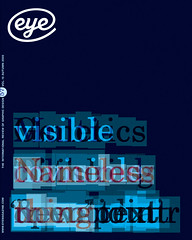Autumn 2005
Editorial Eye 57
The editor summarises the contents of the latest issue of Eye
Science and technology are often mentioned in the same breath, but they are not the same thing. As designers, image-makers and writers, we can become quite blasé about technological advances – from the speed and memory capacity of computers to satellite communications – with only the vaguest notion of the scientific principles, research, inspiration and hard work involved in their development.
Yet there are many good reasons why the visually literate should become scientifically literate. One of the great vogues of recent years has been Sci-Art, which has led to a number of well funded collaborations between scientists and contemporary artists that explore topics such as the nature of pain, birdsong, the aurora borealis and so on. (A recent ICA forum was entitled ‘Sci-Art: Collaboration or Con?’) The gulf between cultures can often mean that artists and scientists are equally mystified by each other’s processes – a mystification then handed down to the audience for the final work.
Science and graphic design are more obvious bedfellows than science and art. Both scientists and designers have an interest in discovering and communicating the truth. In his article ‘Making visible the invisible’, Stuart McKee looks at a project that aims to get them working together, the ‘Image And Meaning 2’ conference in Los Angeles. Of course some of the images have an ‘eye candy’ value, as we see in the spectacular images of viruses (see cover back), or in organiser Felice Frankel’s famous yeast photograph, but the fact remains that in our screen-dominated world, scientists will increasingly need the services of graphic designers and image-makers in order to communicate with a public more inclined to analyse a soap opera than a molecule.
Perhaps designers are the people who can convince school-leavers to study science and medicine rather than the ‘soft’ options of media and design, where degree courses are overflowing with students. But before we get too despondent about the long-term health of the design education sector, it is worth reading Steve Rigley’s positive and thought-provoking essay about the role of letterpress printing in contemporary art and design colleges, which includes some exceptional student work.
The ‘science and design’ theme continues in Picture (Stanley Donwood’s Plat du Jour packaging) and in Katherine Gillieson’s study of children’s information books, ‘Genetics of the “open” text’, while the sub-themes of newsprint and music are explored in articles by Chris Brawn, Will Hoon, Steven Heller and Rick Poynor.
Sadly, this is the last issue of Eye to be art directed and designed by Nick Bell, who has decided to leave the magazine after nearly eight years (31 issues, starting with no. 27). I am grateful for Nick’s loyalty and friendship, and I would also like to pay tribute to his huge contribution to Eye over the years: for the way his design simplifies and clarifies the editorial process; for his knowledge of graphic design history; for his deep understanding of space, form, type and colour; and for his tenacity in maintaining and improving standards of design and production over a period of technological change.
Fortunately Nick won’t be far away. As well as contributing occasional articles and reviews, he will remain part of our team as an adviser and design consultant to Eye as the journal moves closer to the time of its next redesign in Autumn 2006.
First published in Eye no. 57 vol. 15.
Eye is the world’s most beautiful and collectable graphic design journal, published for professional designers, students and anyone interested in critical, informed writing about graphic design and visual culture. It is available from all good design bookshops and online at the Eye shop, where you can buy subscriptions, back issues and single copies of the latest issue.

